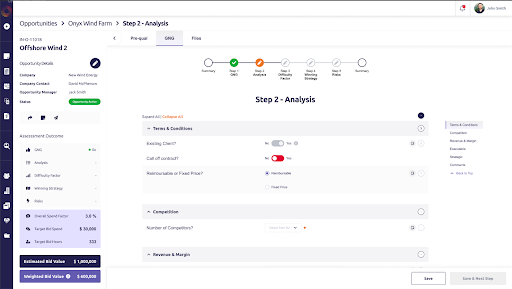Project opportunity bid/no-bid assessment (or go/no-go) is a critical tool used to evaluate the feasibility, viability, and readiness of a project for initiation or continuation. Many companies across various industries use a bid/no-bid assessment to evaluate potential projects in Engineering and Construction (Bechtel Corporation, Fluor Corporation, AECOM,) Aerospace (Lockheed Martin, Boeing, Raytheon), Consulting (Wood, McKinsey & Company, Boston Consulting Group, Bain & Company)
These companies, among many others, typically have a formal process in place for evaluating potential projects before committing resources to bid on them. The bid/no-bid assessment helps make informed decisions about which projects to pursue, based on factors such as profitability, risks, and alignment with their strategic goals and capabilities. It also helps in identifying potential opportunities, constraints, and challenges that may arise during the project’s implementation.
In this article, we look at best practices for carrying out a bid/no-bid assessment, considering what criteria should be included in an evaluation and what benefits this will bring to your company.
What problems does a project opportunity assessment solve?
The process of conducting a project opportunity assessment helps to solve several problems, including:
- Minimizing Risk: The go/no-go assessment helps to identify potential project risks and mitigate them before the project starts, minimizing the risk of project failure or cost overruns.
- Ensuring Feasibility: The go/no-go assessment helps to evaluate the feasibility of a project and ensure that it aligns with the organization’s capabilities, expertise, and resources, reducing the likelihood of project failure.
- Maximizing Return on Investment: The go/no-go assessment helps to evaluate the potential profitability of a project and ensure that it provides a good return on investment for the organization. This also considers the process of investing in the proposal writing process which often uses up a vast amount of time, particularly for seller-doer team members who not only win work but do the project work as well.
- Focusing Resources: The go/no-go assessment helps to ensure that resources are focused on projects that align with the organization’s strategic goals and priorities, reducing the likelihood of wasted resources.
- Improving Communication: The go/no-go assessment helps to ensure that all stakeholders are involved and informed throughout the project lifecycle, improving communication and reducing the likelihood of misunderstandings or miscommunications.
By solving these problems, the go/no-go assessment helps to ensure that projects are well-planned, well-executed, and well-managed and that they provide value to the organization.
What happens if a company doesn’t have a process for assessing project opportunities?
Project opportunity assessment is something every company that enters a tendering process will do albeit inconsistently and informally. If a team has the opportunity to pitch for business, someone at some point makes the decision whether or not to submit a proposal. Most of the time this is done either in a meeting sitting around a table, or even by one team member, making a decision based often on pure gut feel. It is often not a formalized process.
Failing to carry out an adequate project bid/no-bid assessment can result in costly mistakes, missed opportunities, and negative impacts on the organization’s reputation and financial performance. Some of the reasons why companies may fail to conduct an adequate bid/no-bid assessment include:
- Lack of Time: Sometimes, companies are under pressure to submit a bid quickly, which can lead to a rush in the bid/no-bid assessment process, and not enough time is given to evaluate the project properly.
- Lack of Resources: Smaller businesses may not have the necessary resources, such as staff numbers, expertise, or software, to conduct a thorough bid/no-bid assessment.
- Overconfidence: Companies may be overly confident in their abilities and believe they can deliver any project, regardless of its complexity or scope.
- Bias: Companies may be biased towards pursuing certain projects, even if they do not align with their capabilities, expertise, or strategic goals.
- Incomplete Information: Sometimes, companies may not have access to complete or accurate information about the project, which can make it difficult to conduct an adequate bid/no-bid assessment.
Failing to carry out an adequate bid/no-bid assessment can lead to costly mistakes, such as pursuing a project that is not feasible or profitable, underestimating project risks, or missing out on a profitable opportunity. It is, therefore, essential for companies to invest adequate time, resources, and expertise in the bid/no-bid assessment process, to ensure that they make informed decisions about which projects to pursue.
What is involved in project opportunity assessment?
The goal of project opportunity assessment is to make informed decisions about whether to proceed with a project, modify its scope or direction, or abandon it altogether. A team compromising the key stakeholders needs to work through a risk-based decision-making process to decide whether to go for a bid or not go for a bid. One essential part of this process is to ensure that a digital record is created so that this can be shared and analyzed on a global scale. If you are entering many bids, you need to be able to view your bid rate and see why you made decisions. These are key insights that you can’t learn if the data is sitting in someone’s inbox or on a meeting room whiteboard.
The criteria you assess to evaluate whether or not your company enters a bid or not will vary from company to company. However, there are key areas that will always need to be considered to justify committing time and resources to a costly proposal. These include looking at a project’s technical, financial, organizational, and environmental factors, (and don’t forget the terms and conditions) to determine whether it is worth pursuing. Don’t forget the objective is to increase the likelihood of project success so your assessment need to interrogate whether your company can achieve the project’s goals while minimizing potential losses and negative impacts.
What should be included in a project opportunity assessment checklist?
A project opportunity assessment like that included in the Proteus Opportunities feature is built around a go/no-go checklist. This is a critical tool used to evaluate the viability, and readiness of a project. Here are some of the items that could be included in a project go/no-go checklist:
Scope: Is the project scope clearly defined and understood by all stakeholders, including the project team and project sponsor?
Resources: Are the necessary resources, including budget, personnel, and equipment, available to support the project?
Risks: Have potential project risks been identified, assessed, and mitigated? Are there contingency plans in place?
Schedule: Is there a realistic and achievable project schedule in place, with milestones and deliverables clearly defined?
Stakeholders: Have all project stakeholders been identified and engaged, including sponsors, customers, end-users, and project team members?
Communication Plan: Is there a clear communication plan in place to ensure that all stakeholders are informed and involved throughout the project lifecycle?
Quality: Are there clear quality standards in place to ensure that the project deliverables meet the required specifications and quality standards?
Metrics and Reporting: Are there clear project metrics and reporting requirements in place, including performance indicators and regular progress reports?
A comprehensive project go/no-go checklist should be customized to the specific needs of the organization and project and should be used to guide the decision-making process for project initiation or continuation.
How you can streamline the proposal opportunity assessment process?
Project or proposal opportunity assessment is an essential workflow or process that happens right at the beginning of the project life cycle. This does not have to be time-consuming or just another piece of administration that a project team has little time to do. If you develop a standardized process for proposal opportunity assessment this can help streamline the work involved. Clearly defining roles and responsibilities for each team member involved in the proposal opportunity assessment can help ensure that everyone is accountable for their contributions. Using a project management software tool like Proteus, can help streamline the proposal opportunity assessment process by automating repetitive tasks, scheduling reminders, and tracking progress.
By streamlining the proposal opportunity assessment process, organizations can reduce the time and resources required to evaluate opportunities, and focus on pursuing opportunities that align with their strategic goals and have a higher chance of success.

About Proteus
Proteus developed by a Scottish-based tech company, Xergy Group, is an end-to-end project management solution developed for the energy and engineering consulting industries.
Proteus is industry-proven and enables consultancies to meet project demands across the full lifecycle, from proposal development to project delivery. With robust sales and project delivery modules, Proteus helps its customers win more business, increase efficiencies, manage expenditures, and improve project controls.
Critical workflows, automation, and controls are integrated into Proteus. These include opportunity evaluation, proposal building, resource planning, budget tracking and forecasting, real-time multi-level restricted dashboards, and project performance analytics.
Third-party integrations and customised solutions allow Proteus’ users, which include C-suite, project leads, and engineers, to get the exact software solution needed for their business.
We offer a free onboarding consultation service to ensure your company account is set up to your company’s needs.
How to get Proteus
Proteus operates under a software-as-a-service (SaaS) model. We offer Enterprise packages and flexible pricing solutions: contact our team to learn more.
We designed Proteus to be simple, and that means you can get up and running on Proteus without an IT team or support from a programmer. You will want to spend a bit of time configuring the admin console so that you have everything set up to suit your company structure, but it’s very intuitive and you don’t need a PhD in IT.
However, we want you to get the best out of what is a brilliantly powerful tool, so don’t hesitate to ask for our support. We have a team of product experts who are ready to help you with the configuration process, so get in touch today by filling out the form below:



